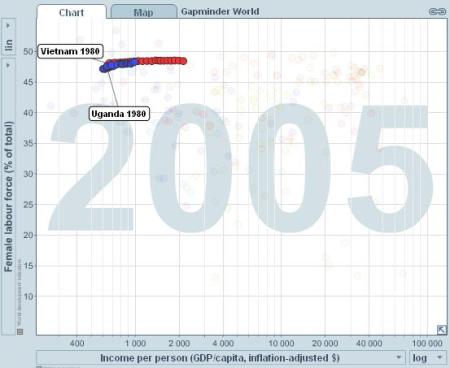I would rather trust a woman’s instinct than a man’s reason.
~Stanley Baldwin
I am giving up. I have been reading, for about one month, literature about the relationship between the wealth of a country and the participation of women in that society.
I wanted to find whether there is a relationship between the wealth of a country and the freedom that woman enjoy (or exert). Furthermore, I wanted to find which precedes what, under the “green” (or politically correct?) assumption that the more freedom women enjoy, the wealthier the country is.
According to a 2007 PriceWaterhouseCoopers Women Economic Participation:
It is apparent that any success in promoting gender diversity in the workforce will have a tangible positive impact on economic growth in both the developed and the developing worlds, and that continued focus on this area is therefore warranted
The study compares data from Brazil, China, France, Germany, India, Spain, Sweden, and the United States. Furthermore, The Economist declares that women contribute more to the GNP that new technology or emergent economies (“The Importance of Sex,” April 12 2006).
There are several indicators about women welfare: government legislation, access to education, availability of child care, good business practices, and positive societal perceptions, but the one we have stats for is participation in the workforce, and we can argue that the participation in the workforce is reflection on how easily women can get in the workforce and how easily they can remain there (benefits, equal payment, maternity leave, etc). I am then comparing data from 1980 to 2005 to see the relationship between working women and the wealth of a nation, as measured as GNP per capita. Sadly, after a month of efforts I cannot prove the thesis and, if any, I have found controversial results.
Let see a map relating the % of women in the workforce and the GNP per capita of all the countries in the world, first from 1980, then for 2007. The data is available at gapminder.org.
In 1980, the wealthiest countries in the world are the Oil-rich Arab states (in green) where women rights are very limited, and the participation of women in the workforce is small. In contrast, the poorest countries in the world have a high participation of women in the workforce, arguably for the need of two incomes in these countries’ families.

25 years later, the difference is not much, except that the Oil-rich countries have less income and more women labour force.

With this evidence I venture that the premise that a rich nation will give its women more freedom (measuring as the % of labour participation) is not completely correct. What about the more accepted view that the more women in the workforce make a nation wealthier? Since the poorer the country, the more participation of women due to economic needs, we need to isolate countries and put them on a time line. Does the condition of the country improve as more women participate on the market force? The results are extremely confusing, let’s look at the eight countries form the PWC report:

The DEVELOPED countries increase women participation AND increase level of income. China gets richer but women stay in home, India gets also richer but sends women home, and Brazil manages to stay as poor as 25 years ago despite the steep increase of women in the workforce. Since the PWC study excludes Africa and the Arab countries, let’s see what happened around the world.
Chile, Canada, and Austria pretty much increase participation of women and level of income…

Mauritius and India increase income but send women home.

Vietnam and Uganda started with pretty much equally in gender in the workforce and then increase the income…

And some Latin American and Arab countries increase the participation of women but remain in the same income bracket.

So, it is in developed and western societies where we can appreciate the relation between women participation and level of income. These societies usually are very open and protective to women’s right, and they keep increasing their level of income, but we have examples when participation of women remains low and the income still increase. The subject is too complex to be analysed here, and surely will continue to generate rivers of digital ink in the coming years.



 Posted by mcyclops
Posted by mcyclops 
